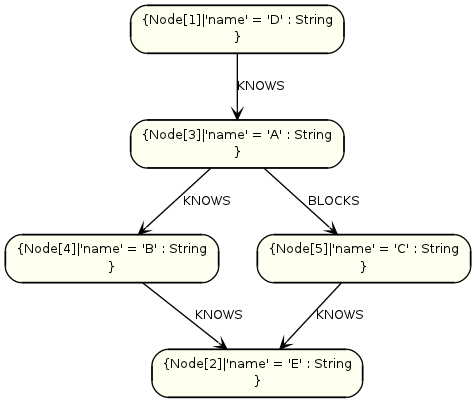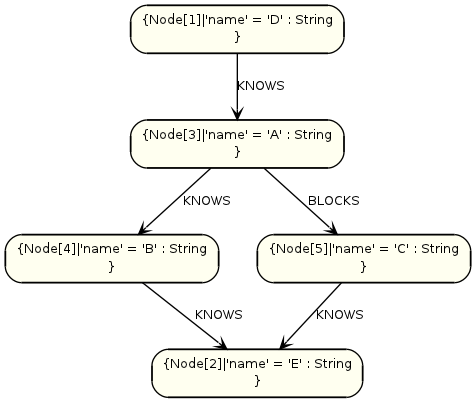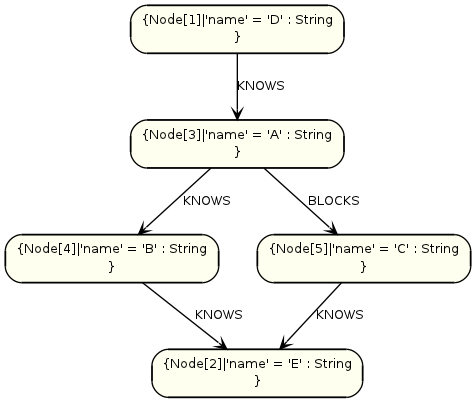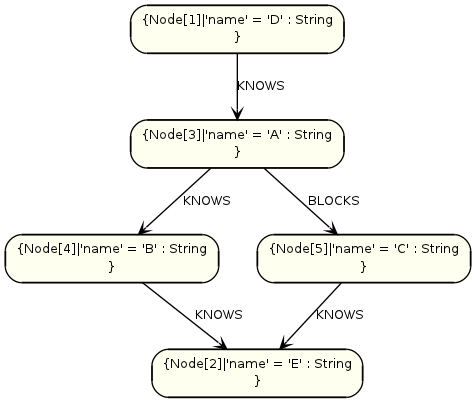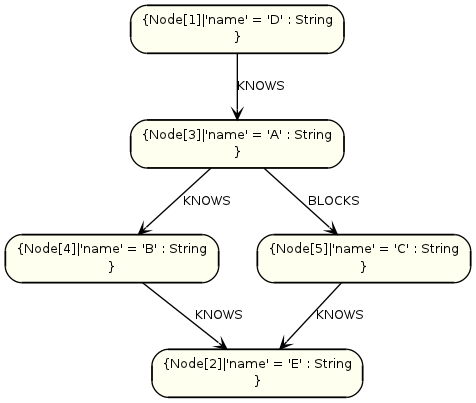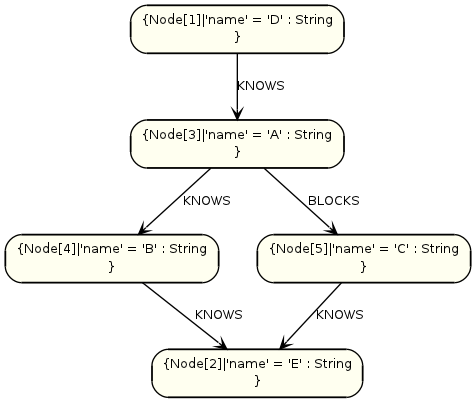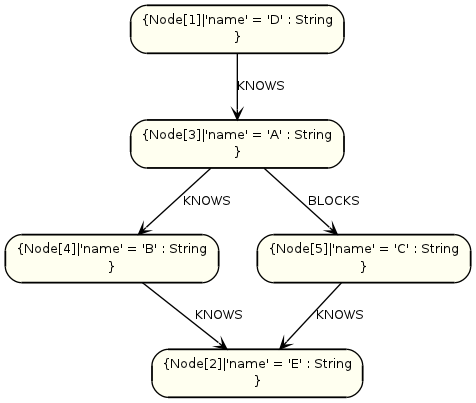- 4.3.1. Related nodes
- 4.3.2. Outgoing relationships
- 4.3.3. Directed relationships and identifier
- 4.3.4. Match by relationship type
- 4.3.5. Match by relationship type and use an identifier
- 4.3.6. Multiple relationships
- 4.3.7. Variable length relationships
- 4.3.8. Optional relationship
- 4.3.9. Optional typed and named relationship
- 4.3.10. Complex matching
In the match part of a query, the pattern is described. The description of the pattern is made up of one or more paths, separated by commas.
All parts of the pattern must be directly or indirectly bound to a start point.
The symbol — means related to, without regard to type or direction.
Graph
Query
start n=(3) match (n)--(x) return x
All nodes related to A are returned
Result
+--------------------+
| x |
+--------------------+
| Node[4]{name->"B"} |
| Node[1]{name->"D"} |
| Node[5]{name->"C"} |
+--------------------+
3 rows, 2 msWhen the direction of a relationship is interesting, it is shown by using --> or <--, like this:
Graph
Query
start n=(3) match (n)-->(x) return x
All nodes that A has outgoing relationships to.
Result
+--------------------+
| x |
+--------------------+
| Node[4]{name->"B"} |
| Node[5]{name->"C"} |
+--------------------+
2 rows, 2 msIf an identifier is needed, either for filtering on properties of the relationship, or to return the relationship, this is how you introduce the identifier.
Graph
Query
start n=(3) match (n)-[r]->() return r
All outgoing relationships from node A.
Result
+---------------+
| r |
+---------------+
| :KNOWS[0] {} |
| :BLOCKS[1] {} |
+---------------+
2 rows, 1 msWhen you know the relationship type you want to match on, you can specify it by using a colon.
Graph
Query
start n=(3) match (n)-[:BLOCKS]->(x) return x
All nodes that are BLOCKed by A.
Result
+--------------------+
| x |
+--------------------+
| Node[5]{name->"C"} |
+--------------------+
1 rows, 1 msIf you both want to introduce an identifier to hold the relationship, and specify the relationship type you want, just add them both, like this.
Graph
Query
start n=(3) match (n)-[r:BLOCKS]->() return r
All BLOCK relationship going out from A.
Result
+---------------+
| r |
+---------------+
| :BLOCKS[1] {} |
+---------------+
1 rows, 1 msRelationships can be expressed by using multiple statements in the form of ()--(), or they can be stringed together, like this:
Graph
Query
start a=(3) match (a)-[:KNOWS]->(b)-[:KNOWS]->(c) return a,b,c
The three nodes in the path.
Result
+--------------------------------------------------------------+
| a | b | c |
+--------------------------------------------------------------+
| Node[3]{name->"A"} | Node[4]{name->"B"} | Node[2]{name->"E"} |
+--------------------------------------------------------------+
1 rows, 2 msNodes that are variable number of relationship→node hops can be found using the -[:TYPE^minHops..maxHops]→.
Graph
Query
start a=(3), x=(2, 4) match a-[:KNOWS^1..3]->x return a,x
The three nodes in the path.
Result
+-----------------------------------------+
| a | x |
+-----------------------------------------+
| Node[3]{name->"A"} | Node[2]{name->"E"} |
| Node[3]{name->"A"} | Node[4]{name->"B"} |
+-----------------------------------------+
2 rows, 2 msIf a relationship is optional, it can be marked with a question mark. This similar to how a SQL outer join works, if the relationship is there, it is returned. If it’s not, null is returned in it’s place. Remember that anything hanging of an optional relation, is in turn optional, unless it is connected with a bound node some other path.
Graph
Query
start a=(2) match a-[?]->x return a,x
A node, and null, since the node has no relationships.
Result
+-----------------------------+
| a | x |
+-----------------------------+
| Node[2]{name->"E"} | <null> |
+-----------------------------+
1 rows, 1 msJust as with a normal relationship, you can decide which identifier it goes into, and what relationship type you need.
Graph
Query
start a=(3) match a-[r?:LOVES]->() return a,r
A node, and null, since the node has no relationships.
Result
+-----------------------------+
| a | r |
+-----------------------------+
| Node[3]{name->"A"} | <null> |
+-----------------------------+
1 rows, 1 msUsing Cypher, you can also express more complex patterns to match on, like a diamond shape pattern.
Graph
Query
start a=(3) match (a)-[:KNOWS]->(b)-[:KNOWS]->(c), (a)-[:BLOCKS]-(d)-[:KNOWS]-(c) return a,b,c,d
The four nodes in the path.
Result
+-----------------------------------------------------------------------------------+
| a | b | c | d |
+-----------------------------------------------------------------------------------+
| Node[3]{name->"A"} | Node[4]{name->"B"} | Node[2]{name->"E"} | Node[5]{name->"C"} |
+-----------------------------------------------------------------------------------+
1 rows, 3 ms